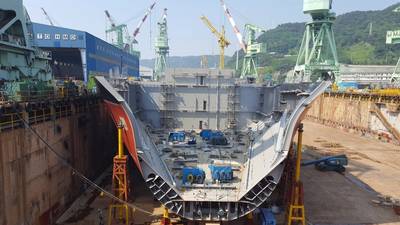Independent research and consultancy firm Maritime Strategies International (MSI) has forecast a structural change to future shipping cycles, driven by increased volatility in newbuilding activity.
In an article by Dr. Adam Kent, MSI notes that as a consequence of the current glut of excess shipyard capacity, many yards will be well-positioned to take orders and deliver within two years, should freight markets show improvement.
“This may mean that we are set to see a something of a structural change in the shipping cycles going forward, with shorter, sharper cycles with any bull run culled by the relative rapid delivery of legions of ships via the new dynamic shipyard capacity landscape,” Dr. Kent suggests.
The speed at which shipyard capacity is able to react to increased contracting volumes was witnessed during the eco ship ‘boom’ of 2013, he explains.
“After the rapid reduction in shipyard capacity, when the Chinese-led contracting explosion ended in 2008, shipyard capacity was shown to be very elastic and responsive and increased again to meet the requirements of owners wanting to place new orders.”
This elasticity will act to dampen the outlook for earnings, which in many trades are expected to show improvement over the next five years as the demand-side improves, compared to the last five years.
“Looking at Compound Annual Growth Rates based on MSI’s assessment of demand in a number of major shipping sectors, crude tankers, containers, chemical tankers all have better prospects over the next five years,” he adds.
Convert this into growth in shipping requirements by factoring in distances, speed, port times, waiting time and ballast ratios, the picture becomes even more positive for crude tankers and containers, chemical tankers and LNG carriers.
However, the supply side remains the source of most problems and despite some recent corrections, the order book still casts a long shadow over most sectors. Across all the main commodity sectors the order book significantly outstrips the ageing fleet with MPP, Ro-Ro and PCTC the only sectors where there is a better balance of replacement tonnage requirements.
But shipyards will still be hungry for orders because, based on scheduled order books and maximum historical output, the three main shipbuilding nations are only fully utilized for 2016. In 2017 utilization drops to around 70 percent in Korea and Japan and is close to 50 percent in China.
The effect of this combination of factors on second-hand prices can be seen from Net Replacement Value (NRV) depreciation which normalizes second-hand prices for movements in newbuilding price and nets out the scrap steel value to capture the intrinsic value of the vessel, with a very good correlation to earnings.
Where earnings are strong the depreciation approaches a straight line – as recently seen in tankers and other specialized sectors – but in weak markets the depreciation curve exhibits more of a convex shape and asset life expectancy is also reduced.
“Looking forward, we expect the NRV metric to improve from today’s position. Bulkers will see roughly a 20 percent improvement by 2018 versus today’s position and containers increases of between 5 percent and 10 percent. Although we expect the tanker markets to soften over the course of the next two years the actual reduction in NRV will be limited to around 5 percent,” he concludes.











